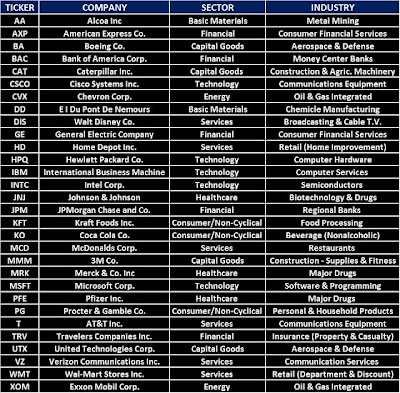In fact, many investors and economist believe the stock market reveals economic conditions about 6 months in advance. This means a rising market, reflects collective investor optimism of near term improvements of economic conditions. The reverse of course is also true. Falling markets may reflect investor pessimism for improvements in the economy, in the near future. These characteristics gives the DJIA even more value, using it to as a barometer to measure the performance of the general market, and economic conditions. These combined characteristics, makes the Dow Industrial Average a powerful forecasting tool for any investor. Below are the companies in the Dow Industrial Average. The list is sorted in alphabetical order by ticker and includes Sectors and Industry Groups, each company belongs to. I have also created a table and embedded live charts of the Dow Jones Industrial Average on my website as well as live updating charts of the Dow Diamonds, an ETF that is designed to track the movements of this Index.
July 7, 2011
DJIA or Dow Jones Industrial Average
In fact, many investors and economist believe the stock market reveals economic conditions about 6 months in advance. This means a rising market, reflects collective investor optimism of near term improvements of economic conditions. The reverse of course is also true. Falling markets may reflect investor pessimism for improvements in the economy, in the near future. These characteristics gives the DJIA even more value, using it to as a barometer to measure the performance of the general market, and economic conditions. These combined characteristics, makes the Dow Industrial Average a powerful forecasting tool for any investor. Below are the companies in the Dow Industrial Average. The list is sorted in alphabetical order by ticker and includes Sectors and Industry Groups, each company belongs to. I have also created a table and embedded live charts of the Dow Jones Industrial Average on my website as well as live updating charts of the Dow Diamonds, an ETF that is designed to track the movements of this Index.
Subscribe to:
Post Comments (Atom)


No comments:
Post a Comment